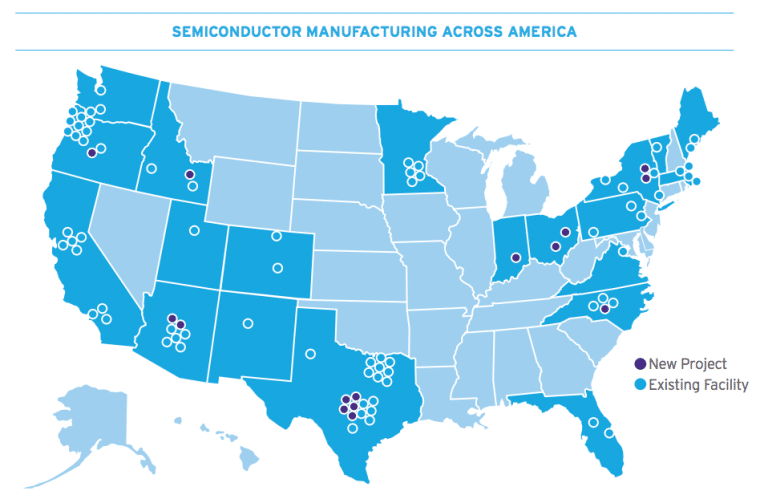The Biden administration announced a $162 million package to support expanded semiconductor manufacturing by Microchip Technology across facilities in Colorado and Oregon. The grant marks the administration’s latest move under the CHIPS and Science Act to strengthen America’s chip production capacity and reduce reliance on overseas supply chains.
According to Commerce Secretary Gina Raimondo, the funding will allow Microchip to “greatly boost its US production of microcontroller units (MCUs) and other specialized semiconductors.” She estimated that the expansion could create more than 700 direct jobs in construction and manufacturing while ensuring a steady supply of important components for cars, appliances, cell phones, and defense systems.
Bolstering Supply of Critical Legacy Chips
The lack of available legacy chips – mature node semiconductors that power essential products – has become a roadblock to multiple US industries, particularly throughout the pandemic because most microchips are made outside of the US.
The administration singled out shortages of Microchip’s microcontrollers and pointed to analysis suggesting even brief microcontroller supply disruptions can impact over 1% of global GDP growth.
Also read: Intel Launches Breakthrough New AI Chips Set to Boost Industry Growth
The company’s legacy chips also play important roles across medical devices, industrial equipment, aerospace systems, and defense technologies.
With the new funding, Microchip expects to triple its output of these critical legacy components across its Colorado and Oregon fabs.
Raimondo said that the increased domestic capacity will decrease reliance on overseas foundries and “strengthen supply chain resilience”.
“This manufacturing investment in Oregon and Colorado will advance the President’s goal of making semiconductors in America again and reducing reliance on global supply chains that led to price spikes and long wait lines for everything from autos to washing machines during the pandemic”, highlighted Lael Brainard, the White House’s National Economic Advisor.
First Company Investment Under $52B Incentives Package

The incentives represent the Biden administration’s first company-specific investment under the landmark $52 billion CHIPS and Science Act passed in 2022.
The legislation specifically aims to boost production capacity for mature node semiconductors. Many legacy chips meeting commercial or defense needs come from this category.
The bill established both grants and tax credits to support new facilities, manufacturing expansion, and research initiatives with the overarching goals of creating jobs, improving national security, and making more chips in America.
“With this proposed investment, President Biden is delivering on his promise to rebuild America’s semiconductor supply chain, creating a more secure defense industrial base, lower prices for Americans, and over 700 jobs across Colorado and Oregon”, Secretary Raimondo emphasized.
Funds Will Be Allocated to Plan Modernization and Workforce Expansion
The package would allocate $90 million to modernize Microchip’s facility in Colorado Springs. The site manufactures microcontrollers for automotive, aerospace, and defense applications.
Another $72 million goes towards expanding the manufacturing capabilities of industrial microcontrollers at the company’s plant in Gresham, Oregon.
Also read: Microsoft Unveils Custom AI Chips to Boost Azure and Reduce Reliance on GPUs
Microchip previously detailed plans to invest $800 million over six years toward significantly expanding its capacity in Gresham. The facility opened in 2022 following a $1.5 billion renovation enabling 12-inch wafer production.
Microchip’s President, Ganesh Moorthy, said that the proposed federal incentives would strengthen the company’s initiatives already underway at the sites.
More Awards Coming Says Commerce Department
Secretary Raimondo noted that today’s Microchip announcement represents just the second project to reach the preliminary funding stage under the CHIPS incentives program.
The first came in December with $35 million in planned support for BAE Systems to expand domestic chip production for military systems.
Raimondo said a significant number of applications have been received, meaning that many more sizable grants will probably be assigned in the near future.
Also read: Nvidia and Qualcomm Battle for the top spot in AI chip efficiency tests
The Secretary told Reuters in early December that the government expects to allocate funds to at least a dozen new projects this year. The grants may add up to billions and may result in a dramatic reshaping of America’s semiconductor industry.
Building Semiconductor Independence
Raimondo said that the program’s initial priority was increasing domestic access to legacy chips like those made by Microchip.
However, she expects that subsequent investments will focus more on stimulating advanced semiconductor manufacturing and packaging capabilities that are currently absent in the US
The Secretary said that fully capitalizing on the $52 billion chip investment ultimately requires hitting benchmarks around manufacturing presence, research leadership, and chip security.
She pointed to goals including upping America’s global chip production tally from 12% currently to 20% by 2030. Raimondo also highlighted the need for cutting-edge domestic foundry capacity beyond existing legacy fabs.
Meanwhile, surveys of US chip inventories and reliance carry implications for supply chain visibility and semiconductor policy. The Department of Commerce itself continues scrutinizing potential risks around Chinese-produced legacy chip infiltration.
With the CHIPS incentives now flowing, the Biden administration believes America can reestablish its prominence in this strategic economic sector. The country’s ultimate vision relies on consistent and substantial private-public sector collaboration.
The Microchip funding milestone marks a first step forward in remedying domestic chip deficiencies while fostering jobs and competitiveness.